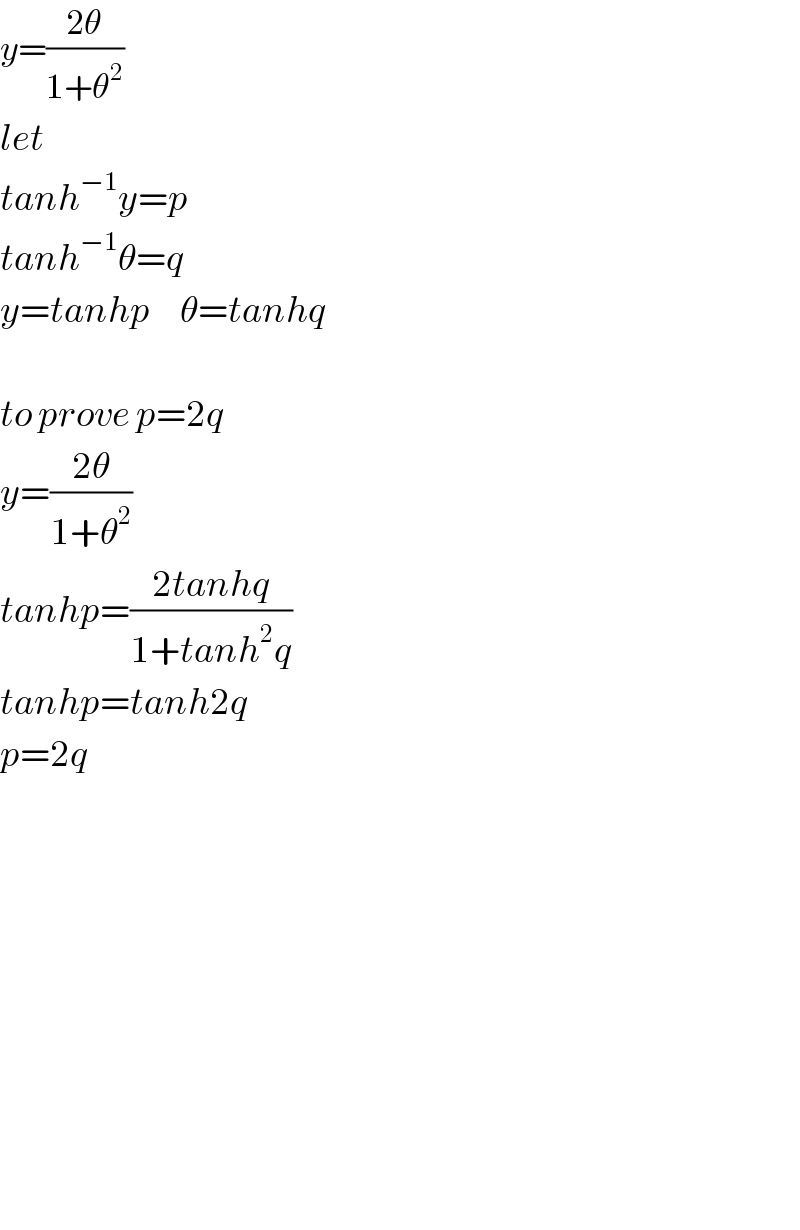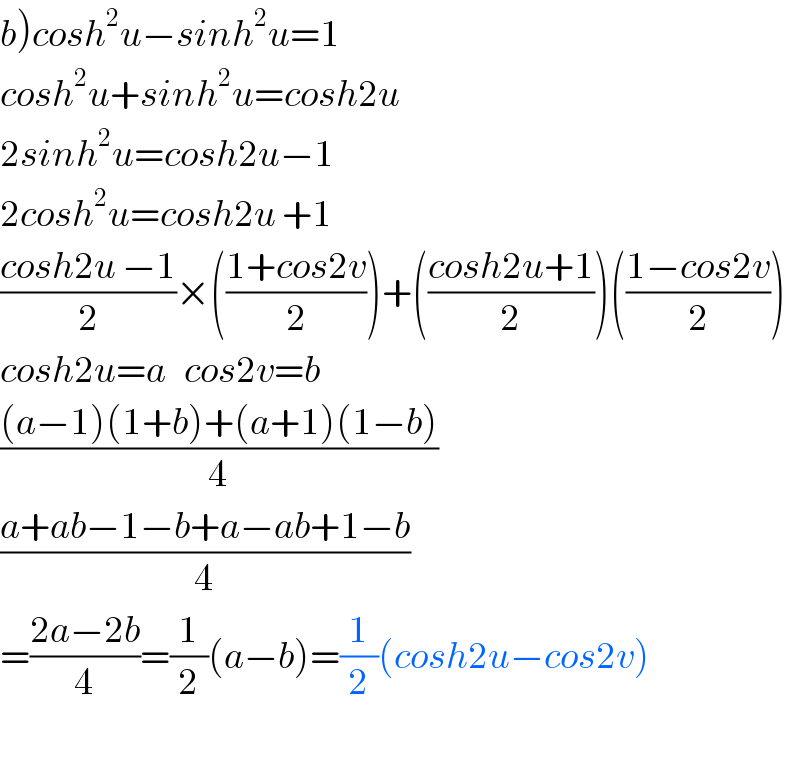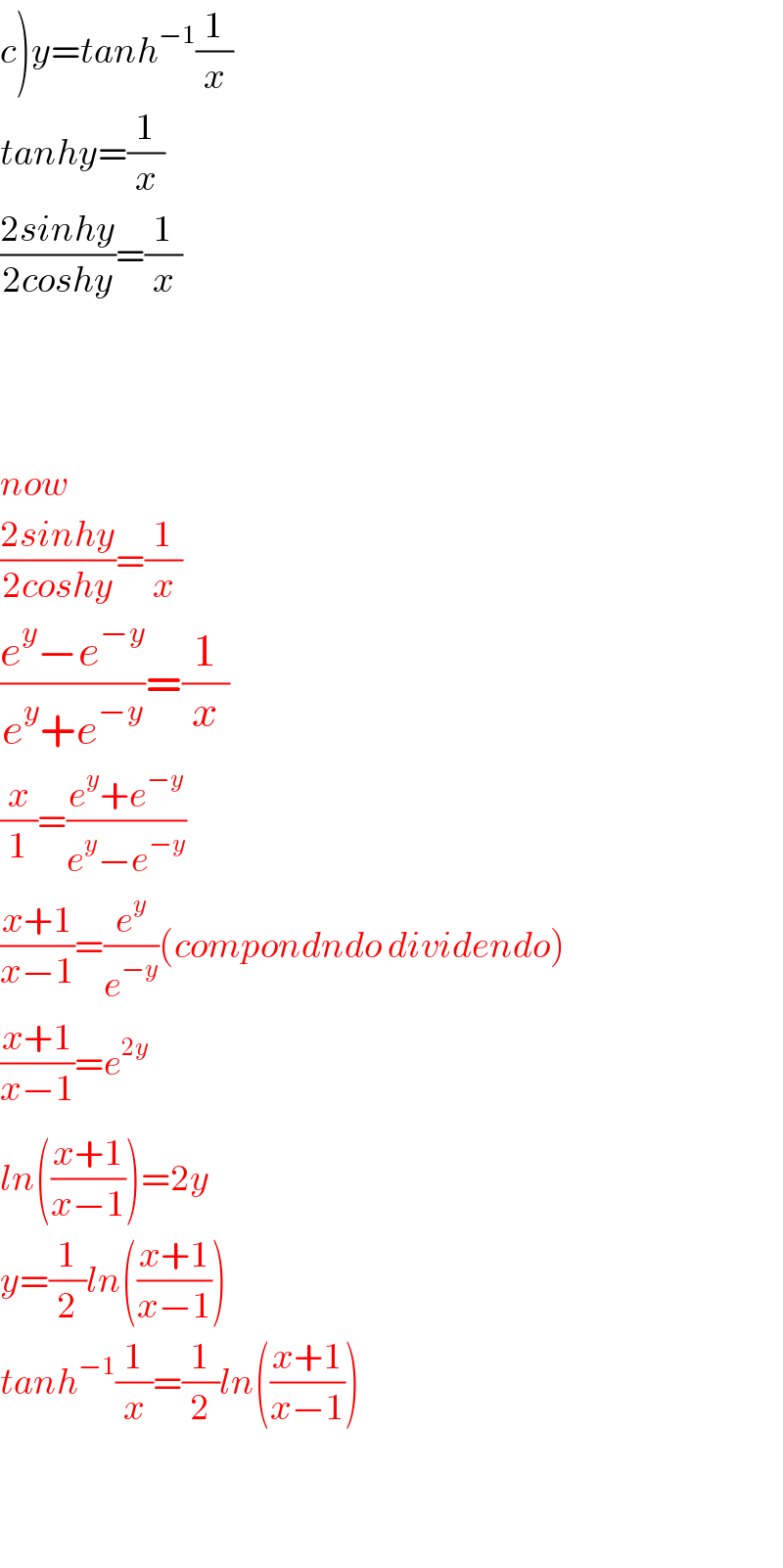Question Number 44097 by peter frank last updated on 21/Sep/18

Answered by tanmay.chaudhury50@gmail.com last updated on 22/Sep/18

$${y}=\frac{\mathrm{2}\theta}{\mathrm{1}+\theta^{\mathrm{2}} } \\ $$$${let} \\ $$$${tanh}^{−\mathrm{1}} {y}={p} \\ $$$${tanh}^{−\mathrm{1}} \theta={q} \\ $$$${y}={tanhp}\:\:\:\:\:\theta={tanhq} \\ $$$$ \\ $$$${to}\:{prove}\:{p}=\mathrm{2}{q} \\ $$$${y}=\frac{\mathrm{2}\theta}{\mathrm{1}+\theta^{\mathrm{2}} } \\ $$$${tanhp}=\frac{\mathrm{2}{tanhq}}{\mathrm{1}+{tanh}^{\mathrm{2}} {q}} \\ $$$${tanhp}={tanh}\mathrm{2}{q} \\ $$$${p}=\mathrm{2}{q} \\ $$$$ \\ $$$$ \\ $$$$ \\ $$$$ \\ $$$$ \\ $$$$ \\ $$$$ \\ $$$$ \\ $$
Answered by tanmay.chaudhury50@gmail.com last updated on 22/Sep/18

$$\left.{b}\right){cosh}^{\mathrm{2}} {u}−{sinh}^{\mathrm{2}} {u}=\mathrm{1} \\ $$$${cosh}^{\mathrm{2}} {u}+{sinh}^{\mathrm{2}} {u}={cosh}\mathrm{2}{u} \\ $$$$\mathrm{2}{sinh}^{\mathrm{2}} {u}={cosh}\mathrm{2}{u}−\mathrm{1} \\ $$$$\mathrm{2}{cosh}^{\mathrm{2}} {u}={cosh}\mathrm{2}{u}\:+\mathrm{1} \\ $$$$\frac{{cosh}\mathrm{2}{u}\:−\mathrm{1}}{\mathrm{2}}×\left(\frac{\mathrm{1}+{cos}\mathrm{2}{v}}{\mathrm{2}}\right)+\left(\frac{{cosh}\mathrm{2}{u}+\mathrm{1}}{\mathrm{2}}\right)\left(\frac{\mathrm{1}−{cos}\mathrm{2}{v}}{\mathrm{2}}\right) \\ $$$${cosh}\mathrm{2}{u}={a}\:\:\:{cos}\mathrm{2}{v}={b} \\ $$$$\frac{\left({a}−\mathrm{1}\right)\left(\mathrm{1}+{b}\right)+\left({a}+\mathrm{1}\right)\left(\mathrm{1}−{b}\right)}{\mathrm{4}} \\ $$$$\frac{{a}+{ab}−\mathrm{1}−{b}+{a}−{ab}+\mathrm{1}−{b}}{\mathrm{4}} \\ $$$$=\frac{\mathrm{2}{a}−\mathrm{2}{b}}{\mathrm{4}}=\frac{\mathrm{1}}{\mathrm{2}}\left({a}−{b}\right)=\frac{\mathrm{1}}{\mathrm{2}}\left({cosh}\mathrm{2}{u}−{cos}\mathrm{2}{v}\right) \\ $$$$ \\ $$
Answered by tanmay.chaudhury50@gmail.com last updated on 22/Sep/18

$$\left.{c}\right){y}={tanh}^{−\mathrm{1}} \frac{\mathrm{1}}{{x}} \\ $$$${tanhy}=\frac{\mathrm{1}}{{x}} \\ $$$$\frac{\mathrm{2}{sinhy}}{\mathrm{2}{coshy}}=\frac{\mathrm{1}}{{x}} \\ $$$$ \\ $$$$ \\ $$$$ \\ $$$${now} \\ $$$$\frac{\mathrm{2}{sinhy}}{\mathrm{2}{coshy}}=\frac{\mathrm{1}}{{x}} \\ $$$$\frac{{e}^{{y}} −{e}^{−{y}} }{{e}^{{y}} +{e}^{−{y}} }=\frac{\mathrm{1}}{{x}} \\ $$$$\frac{{x}}{\mathrm{1}}=\frac{{e}^{{y}} +{e}^{−{y}} }{{e}^{{y}} −{e}^{−{y}} } \\ $$$$\frac{{x}+\mathrm{1}}{{x}−\mathrm{1}}=\frac{{e}^{{y}} }{{e}^{−{y}} }\left({compondndo}\:{dividendo}\right) \\ $$$$\frac{{x}+\mathrm{1}}{{x}−\mathrm{1}}={e}^{\mathrm{2}{y}} \\ $$$${ln}\left(\frac{{x}+\mathrm{1}}{{x}−\mathrm{1}}\overset{} {\right)}=\mathrm{2}{y} \\ $$$${y}=\frac{\mathrm{1}}{\mathrm{2}}{ln}\left(\frac{{x}+\mathrm{1}}{{x}−\mathrm{1}}\right) \\ $$$${tanh}^{−\mathrm{1}} \frac{\mathrm{1}}{{x}}=\frac{\mathrm{1}}{\mathrm{2}}{ln}\left(\frac{{x}+\mathrm{1}}{{x}−\mathrm{1}}\right) \\ $$$$ \\ $$$$ \\ $$
